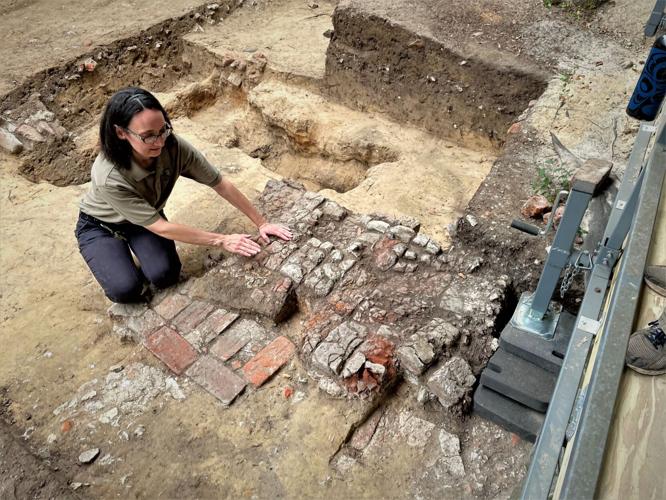Visitors to Charles Towne Landing have seen the beautiful riverfront site where the first English colonists settled shortly after their arrival in 1670, but they haven't been able to see much of the settlement itself.
That will change soon.
Years ago, the state park was remodeled and reinterpreted to emphasize what archaeology can tell us about the founding of the Carolina colony and Charles Towne. A wooden palisade has been built where archaeology showed the original once stood. There were also soil stains from old post holes found years ago, evidence of an early wooden structure. Other digs found traces of an early crop garden and a cannon moat, as well as a Native American ceremonial site.
But all that is nothing like what will await visitors later this summer when the state park unveils extensive recent excavations that shed a new and different light on the colony's first years.
It's a story about a colony far more substantial than first thought, one with several brick buildings, glass windows, neat lime floors and evidence of vibrant trade, with pottery sherds and other trinkets from more than a half a dozen nations.

Archaeologist Nicole Isenbarger examines small remnants found at the 17th century Charles Towne Landing site, including material made in England, Italy, France, Spain and Holland. Robert Behre/staff
"It's making us revise our story," says archaeologist Andrew Agha, whose doctorate focused on how the First Earl of Shaftesbury directed the Carolina settlement by ordering it to test different crops and by modernizing enslaved African labor — all to advance the colony's wealth through science, natural philosophy and experimentation.
The discoveries began quietly several years ago, when Agha found a brick pier near where an old tabby or lime floor had been revealed in 2009. Brick had been unearthed nearby before, but it was interpreted — mistakenly — as 18th century rubble. This was clearly different — and much older. Subsequent excavations nearby revealed remains of a few other brick structures.

This brick foundation was one of the first substantial architectural remnants unearthed at a Charles Towne Landing site just beyond the colony's palisade, or common area. Robert Behre/Staff
"There's so much happening on top of each other here in a short period of time," says Nicole Isenbarger, an archaeologist with the state Department of Parks, Recreation and Tourism (and Agha's wife). "If you read all the history books, they say it (the colony) was floundering and failing ..., but if you read Andrew's research, they knew what they were doing."
And life might have been more comfortable than previously thought.
The excavation site is on the highest bluff (the first settlers probably already knew enough to be wary of floods); it sits not far from the river or the palisade, which would have marked where the colony's common, or communal space, stopped and private property began. The brick remnants, all on what once was private property, currently are covered by a large tent that lets the work proceed slowly without worry about rain and mud.

Archaeologists Nicole Isenbarger and Andrew Agha examine a trove of architectural remnants found in an ongoing Charles Towne Landing dig. The area was recently covered by a tent to allow work to proceed slowly, without concern about rain. Robert Behre/Staff
Inside, the excavated soil shows not only some of the Carolina colony's first buildings but also its first remodeling. "Sometime in the 1670s, they knocked out a wall and put in a fireplace," Isenbarger says of one spot. And that's far from the only structure build on top of or through an earlier one. "There's architecture on top of architecture," she tells me.
But it's not only big stuff. The excavation also found two tokens or "jettons" often used on a counting board that functioned like an abacus. It contains the likeness of King Charles II and reads "CAR*II*DG*MA*BR*FR*ET*HIB*REX," which translates to "Charles by the Grace of God King of Great Britain, France, and Ireland."

This coin containing the likeness of Charles II was unearthed in recent excavations at Charles Towne Landing that discovered substantial, significant development by colonists shortly after they landed there in 1670. Robert Behre/Staff
Ever since the state acquired this site and turned it into a park to mark South Carolina's Tricentennial, archaeologists have been digging carefully for clues about what the first settlement was like. It's been a slow process — one that has stretched over 50 years but still could be considered only in an early stage. After all, archaeology has been under way in ancient Egypt for more than a century and still is unearthing exciting new things.
This summer, the state plans to install new wayside markers to interpret the find, as well as allowing visitors inside the large tent to see the assorted brick and lime remains up close.
Some familiar with Charles Towne Landing inevitably may wonder why its story seems to change so often. It's a good question, and Agha has a good answer — one that has to do with the slow, painstaking work of digging up small bits of the past and analyzing them.
"We tell people what we think was going on, and some people think we're creating a fact," he says, "but we're really just testing ideas."

Archaeologist Nicole Isenbarger examines a pit dug under a 17th century lime floor at Charles Towne Landing in an area that saw significant building by private property owners during the Carolina colony's early years. Robert Behre/staff













